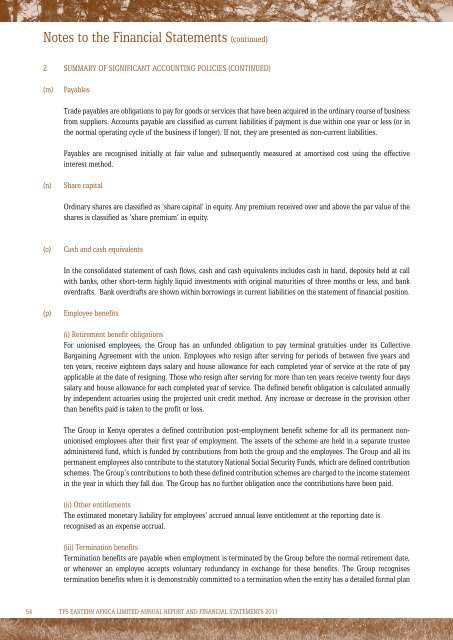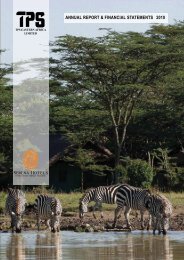2012 TPSEA Annual Report - Serena Hotels
2012 TPSEA Annual Report - Serena Hotels
2012 TPSEA Annual Report - Serena Hotels
Create successful ePaper yourself
Turn your PDF publications into a flip-book with our unique Google optimized e-Paper software.
Notes to the Financial Statements (continued)<br />
2 Summary of significant accounting policies (continued)<br />
(m)<br />
Payables<br />
Trade payables are obligations to pay for goods or services that have been acquired in the ordinary course of business<br />
from suppliers. Accounts payable are classified as current liabilities if payment is due within one year or less (or in<br />
the normal operating cycle of the business if longer). If not, they are presented as non-current liabilities.<br />
Payables are recognised initially at fair value and subsequently measured at amortised cost using the effective<br />
interest method.<br />
(n)<br />
Share capital<br />
Ordinary shares are classified as ‘share capital’ in equity. Any premium received over and above the par value of the<br />
shares is classified as ‘share premium’ in equity.<br />
(o)<br />
Cash and cash equivalents<br />
In the consolidated statement of cash flows, cash and cash equivalents includes cash in hand, deposits held at call<br />
with banks, other short-term highly liquid investments with original maturities of three months or less, and bank<br />
overdrafts. Bank overdrafts are shown within borrowings in current liabilities on the statement of financial position.<br />
(p)<br />
Employee benefits<br />
(i) Retirement benefit obligations<br />
For unionised employees, the Group has an unfunded obligation to pay terminal gratuities under its Collective<br />
Bargaining Agreement with the union. Employees who resign after serving for periods of between five years and<br />
ten years, receive eighteen days salary and house allowance for each completed year of service at the rate of pay<br />
applicable at the date of resigning. Those who resign after serving for more than ten years receive twenty four days<br />
salary and house allowance for each completed year of service. The defined benefit obligation is calculated annually<br />
by independent actuaries using the projected unit credit method. Any increase or decrease in the provision other<br />
than benefits paid is taken to the profit or loss.<br />
The Group in Kenya operates a defined contribution post-employment benefit scheme for all its permanent nonunionised<br />
employees after their first year of employment. The assets of the scheme are held in a separate trustee<br />
administered fund, which is funded by contributions from both the group and the employees. The Group and all its<br />
permanent employees also contribute to the statutory National Social Security Funds, which are defined contribution<br />
schemes. The Group’s contributions to both these defined contribution schemes are charged to the income statement<br />
in the year in which they fall due. The Group has no further obligation once the contributions have been paid.<br />
(ii) Other entitlements<br />
The estimated monetary liability for employees’ accrued annual leave entitlement at the reporting date is<br />
recognised as an expense accrual.<br />
(iii) Termination benefits<br />
Termination benefits are payable when employment is terminated by the Group before the normal retirement date,<br />
or whenever an employee accepts voluntary redundancy in exchange for these benefits. The Group recognises<br />
termination benefits when it is demonstrably committed to a termination when the entity has a detailed formal plan<br />
54 TPS EASTERN AFRICA LIMITED ANNUAL REPORT AND FINANCIAL STATEMENTS 2011





